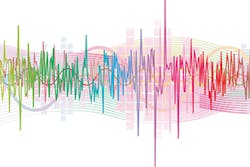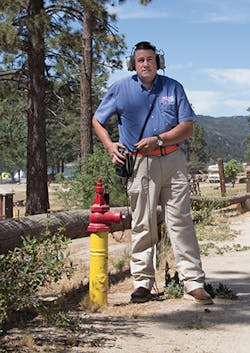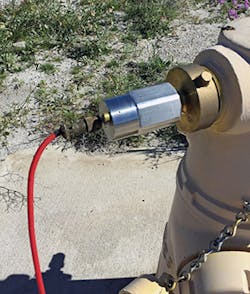Leaks are money, states Eric Stacey, product manager for advanced leak detection solutions at Echologics. Money not just down the drain, but right out the drain! Lost water involves costs for treatment and conveyance that never result in revenue, and further expense is incurred in leak detection and pipeline repair.
“There are all kinds of costs with lost water,” notes Cameron Keyes, director North America, Gutermann Inc. He lists the replacement of meters, decreased revenue, chemical treatment, the cost of electricity for conveyance, and the cost of addressing theft as a few of the expenses incurred due to lost water.
Other related costs include checking the system. “Water districts are supposed to check a percentage of the system each year,” explains Jim Carter, senior director of corporate field services for American Leak Detection. The goal is 5%, he adds.
Not only is there “a lot of old pipe pushing 100 years,” he says, but there is also extensive population growth, making it difficult for utilities to replace lines and keep up with new growth due to time and budget constraints. As with all things, it comes down to money. “Many utilities have a 100-year budget for 60-year pipeline,” says Stacey, adding that the typical budget is 10% per year designated for replacement.
Population stress and water shortage stress are expensive, Stacey says. “Increasing population and lack of water lead to treatment and capacity problems.” Many cities experiencing exponential growth, such as Phoenix, can’t draw more water from the aquifer and because supplies are limited, it’s not always possible to buy sufficient wholesale or bulk water to meet demand.
In the past, Stacey says large capacity often made up for leakage. But with increased demand and a drop in supply, that solution is no longer feasible. A 10% reduction in leaks can mean close to a 13% increase in efficiency. “You must find the leakage,” he concludes.
Bursts happen all the time due to the natural rate of rise. “Leakage increases as pipes age,” says Stacey. Nationally, he says, 16% is average, while below 10% (which is the West Coast average) is excellent, and 25% is average in the Northeast. While he’s not certain if there are more leaks now than ever, Stacey does think “the pain that leaks cause is worse now.”
Bursts have many causes beyond the age of the pipe. For example, connections are an opportunity for leakage. Triggers include a water hammer (the pressure surge when the pump shuts off or a valve closes); pipe failure; ground movement due to seasonal temperature fluctuations or construction; and even pressure from lack of use when pressure is high and consumption is low, a common occurrence overnight. The weak spot bursts first, of course. Stacey says the weak spots are usually a leak.
Echologics’ technology helps crews find leaks before they progress to burst. “We find leaks early and monitor them,” says Stacey. This targeted approach saves money in emergency response, reduces water loss by 5–6 points, and minimizes insurance costs while improving customer service.
CAN YOU HEAR ME NOW?
Leakage is an unfortunate—and inevitable—consequence of pipelines. “It causes less damage if you get to the leak quickly,” says Keyes. Locating leaks not only means digging fewer holes to find and fix them; it also means being able to schedule repairs rather than reacting to emergency bursts.
To get to the leak, first you must locate it. The principle behind electronic leak detection is that all leaks produce sounds. Acoustic leak detection is simply listening for leaks. However, Carter says, “You must be experienced to hear leaks.” That’s because, while all water leaks produce sounds, different types of leaks produce different sounds . . . and every type of pipe creates a different noise. “Different types of leaks sound different.”
A pinhole leak sprays water at high pressure; it’s rather easy to distinguish. “Pinholes provide good noise,” agrees Keyes. “They’re easy to find because they create an acute sound.”
Bigger leaks are harder to find, as are splits, because they “feather-out” as they spray, Carter says. Bad fittings and thin pipes produce weeping and oozing that can’t be heard either. However, according to Stacey (product manager for advanced leak detection solutions at Echologics, a Mueller Water Products company), “seepage,” often caused by gasket degradation, is not always economical to repair. He recommends monitoring, and if the leak progresses, intervening at the right time before it bursts.
Corroded metal pipes leach, producing a muffled noise. Leaks that run parallel with the pipe and wrap-around leaks—in which the diameter may have cracked as the pipe shifted—are difficult to find. But Carter says that tuberculation, or pockmarks, are easy to find. “They make a good noise.”
The type of leak isn’t the only factor influencing the type of sound emitted. “Every pipe type creates a different noise,” explains Keyes. “Cast iron and ductile iron have one frequency; it’s higher—around 300–200 Hz. Plastic has a different frequency.”
Cast iron, ductile iron, and steel are all good conductors of sound, but non-metallic pipes—AC, Z900, or pressure-treated concrete, for example—change the travel distance of sound. “Diameter affects sound,” restates Carter. “Bigger is harder to hear. It also depends on the soil, but pipe material is the biggest thing: metallic and non-metallic.”
A pipe of a certain diameter, material, and pressure has a signature sound, Carter says, adding that there is an algorithm that calculates the sound emitted by specific types and diameters of pipes. It’s harder to find leaks in large-diameter pipe—over 24 inches, for example.
Background noise can also complicate leak detection, although acoustic correlation with the use of two sensors can overcome that obstacle.
A technician uses a survey tool to listen on the hydrants for leak noise.
SENSORS
The technology of acoustic leak detection is changing with the introduction of more advanced ways of going after non-revenue water. One of the biggest developments, according to Keyes, happened 10 years ago with the introduction of the leak noise logger.
Noise loggers collect data and take averages over a period of time. Traditional leak detection is done during the day, but Keyes says they have more flexibility in how they deploy sensors now, allowing them to take advantage of better times. While sensors operate 24 hours a day, they are most effective overnight, when there’s less ambient noise from traffic, trains, and weather.
The best time is at night, Keyes says, and the best place is in a distribution system, not in a hydrant. “There’s less interference there.” But the biggest advancement is how information is communicated. “Customers see that with deployment of Zone-scan in areas they couldn’t do detection in before—such as urban areas.”
And the biggest advancement over a long period of time is the management of battery life. Because sensors are placed across miles of land—and sometimes underground—if the battery dies, it’s an issue. Optimizing when a sensor and the radio communicate maximizes longevity of the battery. If you make the logger communication for a shorter period of time, it uses less battery. “The goal is to hone in on when it’s communicating in a narrow window,” says Keyes.
Traditional sensors are “ground microphones” that are dropped into a box to listen for leaks, Carter explains. “The technology hasn’t changed a lot in 20 years; there’s been some improvement, but they already work well.”
Microphones cling to the exterior of metal pipe with a magnet. Hydrophones work well with non-metal pipes by working on the water column. “The sound travels down the water column, not the pipe,” explains Carter.
A new type of sensor has joined the ranks: the ultrasonic leak detection sensor. Electro-scan is new technology that involves pulling a sensor through a non-metal line. A different type of transmitter is used with steel pipe.
The sensor is hooked behind a cone-shaped device that creates a water column. Crews monitor the water level as they pull it down the line. “It pings where there’s a flaw in the pipe,” explains Carter. “It goes to the ground when it encounters a flaw such as cracks or bad joints. It spikes when it goes to the ground.” It provides the distance from the end of the pipe to the flaw for easy location, and a camera can be laid on the pipe surface to see the leak.
It’s being done on non-potable and potable water pipes, Carter says. “It can be inserted through a fire hydrant, allowing [crews] to investigate the inside of a pipe to see buildup and corrosion.”
Another innovation is the smart ball, which is inserted into a 4-inch opening. Water floats the ball down the line; it pings where there are flaws in the pipe.
CHANGING TECHNOLOGY
Digital technology has changed leak detection, Carter believes. American Leak Detection uses its own state-of-the-art equipment and a variety of equipment from various manufacturers to locate leaks. “Fire hydrants have sensors—permaloggers—to monitor usage and determine the area of leakage. We use leak correlation to pinpoint it. Today, you can do it on a cell phone. Correlation is evolving to stuff you do inside,” as opposed to physically searching for leaks outside.
According to Keyes, Gutermann, which he credits with being at the forefront of technology since 1948, was the first to combine a leak noise logger with a correlation device. “We’re the only provider that combines logging—a survey technique—with a sensor that sits on a valve. Lots of manufacturers can do this, but we also correlate between the sensors to pinpoint the leak. We don’t need to tell two locations to correlate—it does it automatically. It has the ability to hone in on the area of leaks. We’re the only group offering automatic daily correlation.”
Correlation enables crews to find leaks that are tough for our ears to hear and saves time in pinpointing the location of leaks. Automatic daily correlation is particularly beneficial for large utilities covering vast areas that are tough to cover physically, as well as in urban areas with heavy traffic. It records data from leaks in the system. The larger the file becomes, the more leaks the crews can find because they have more data to compare and more information to use to hone in on the leak’s location.
Why now? Correlation is not new. However, it dovetails with other trends, such as smaller, durable, and better radio communication. “Other technology has aligned nicely,” says Stacey, specifically cellular networks. “Data transfer needs reliable networks.” Sensors work on the cellular network—an existing network that each utility does not need to recreate. “It’s more economical to use existing networks.” And easier, he might add, because it’s technology that is familiar to most people.
An external microphone is used to detect leak noise traveling down the exterior of the pipe.
In the past, utilities used purpose-built units, but now they leverage technology from their smartphones, including GPS mapping and audio, according to Keyes. “It dovetails with our sensor technology and it’s affordable,” he says. The unmanned Zonescan logger system has made way for a new system: Easy-scan, with the correlator and listener combined in one unit. The interface is a smartphone, Keyes points out.
One “big problem” in the past with information on a map-based system was the lack of note-taking for accuracy. Conversely, the corresponding advantage of GPS, Keyes states, is consistency, with less risk of error.
FIXED
Another development has resulted from the widespread adoption of cloud computing. “Utilities are open to the cloud environment now because it provides a central place for data to go,” says Keyes.
Utilities are more willing to purchase and use this technology now that many of them host innovation groups to help them stay current on the latest developments, Stacey says.
Before data can be stored, it must be obtained. Echologics, whose customer base consists primarily of municipal water utilities, as well as industrial clients with water as a mission-critical component of their operation, offers a fixed leak detection system. It’s different from other systems that place sensors below ground, which “makes it much harder to get a radio signal out,” says Stacey.
With a fixed leak detection system, sensors are permanently installed in distribution networks. “They’re installed on fire hydrants,” explains Stacey. “We replace the pumper nozzle cap with a cast iron cap with the sensor, a radio, and a battery.” There’s less corrosion, better battery life (up to 5 years), and a better radio signal.
Echologics devised an innovative solution by developing sensors that are similar to smart meters in that they send information directly with automatic correlation. “They are more sensitive sensors,” claims Stacey, with improved quality and increased longevity.
These innovations lead to cost savings in labor and repair due to a lower burst rate. Stacey estimates payback in 3–5 years, noting that the benchmark for a utility to purchase a system is typically 5–8 years.
“With a fixed leak detection system, you can reduce leakage and lower costs,” he summarizes. Although he acknowledges that all water utilities share a certain level of social responsibility to preserve water, he says it can actually be cost-prohibitive to do so. The emotional appeal to save water at all costs is “not enough to justify spending money to find leaks unless you add in [the additional expenses of] labor costs and bursts.” The Echologics system takes all of that into account. In addition, it helps improve customer service by lowering their water bill and finding (and repairing) leaks more quickly.
ONGOING DEVELOPMENT
“It’s amazing how much has changed over six to seven years,” reflects Carter. “You can even do [leak detection] from satellite because you can see water standing around the leak; you can see pooling in a 200–300-foot area—at which time we come in to pinpoint it.”
The use of overhead observation via satellite will probably give way to drones in the future. “We’re already thinking about using drones,” admits Carter.
Integration of acoustic leak detection with other systems takes many forms. Echologics is integrating it with the utility’s work order management system in order to achieve more efficient scheduling.
Stacey believes that this technology is a strong candidate for the trend in machine learning: artificial intelligence. The technology is proven and has gained wider adoption, he says, due in part to better automation and decision-making support. “You can see what leak to go to first.”
Finding leaks, monitoring them, and determining the priority for repairing them is the ultimate goal. “The sooner we find a leak, the more money we save,” says Carter. He believes that water districts should take proactive steps, using electronic meters. “They’re pretty accurate, depending on the meter. The more electronics, the more reliability.”
In fact, some states, including Georgia, Tennessee, and California, mandate that utilities look at technology for improved leak detection, according to Keyes. “It’s one of the drivers of development of better technology,” he says. “The drought in Georgia recently led to aggressive water monitoring. Their justification for leak detection was old infrastructure.”
It pays off. Carter mentions a 165-mile survey in Tennessee that found enough leaks in the first 25 miles to fill a one-million-gallon tank. “The pump only cycles once when the tank is full, saving on the costs of electricity and chemicals to treat the water.”
Carter also mentioned a 44-day survey in Florida that found more than 200. Leaks are rampant everywhere. That’s why it’s a race to find and stop water leaks, which, in turn, creates a race to develop the best system with the best data and the most reliability at the right cost.




